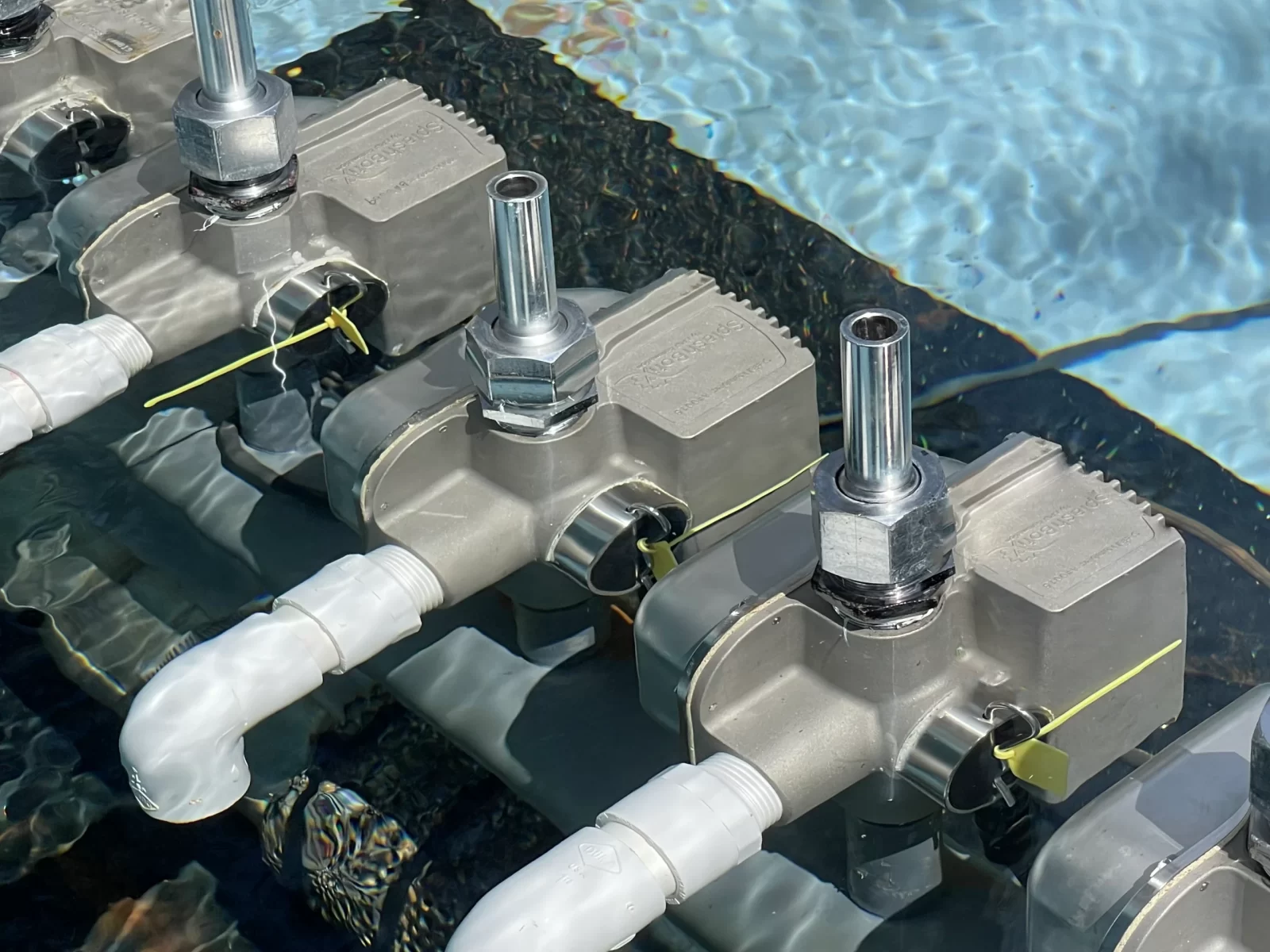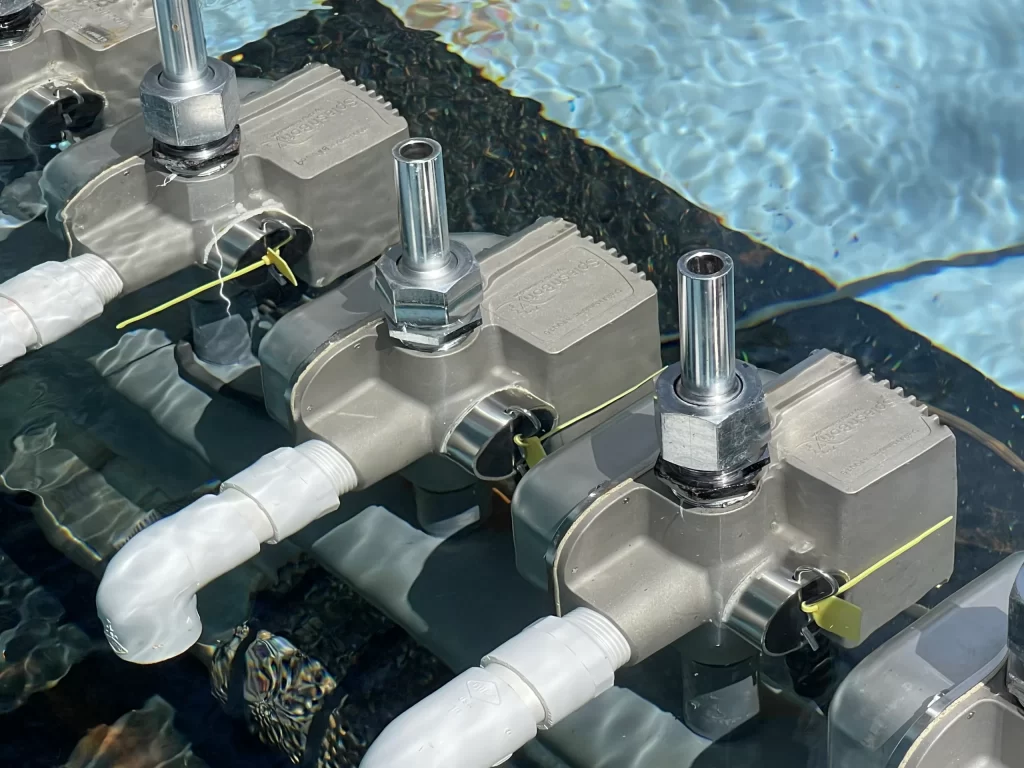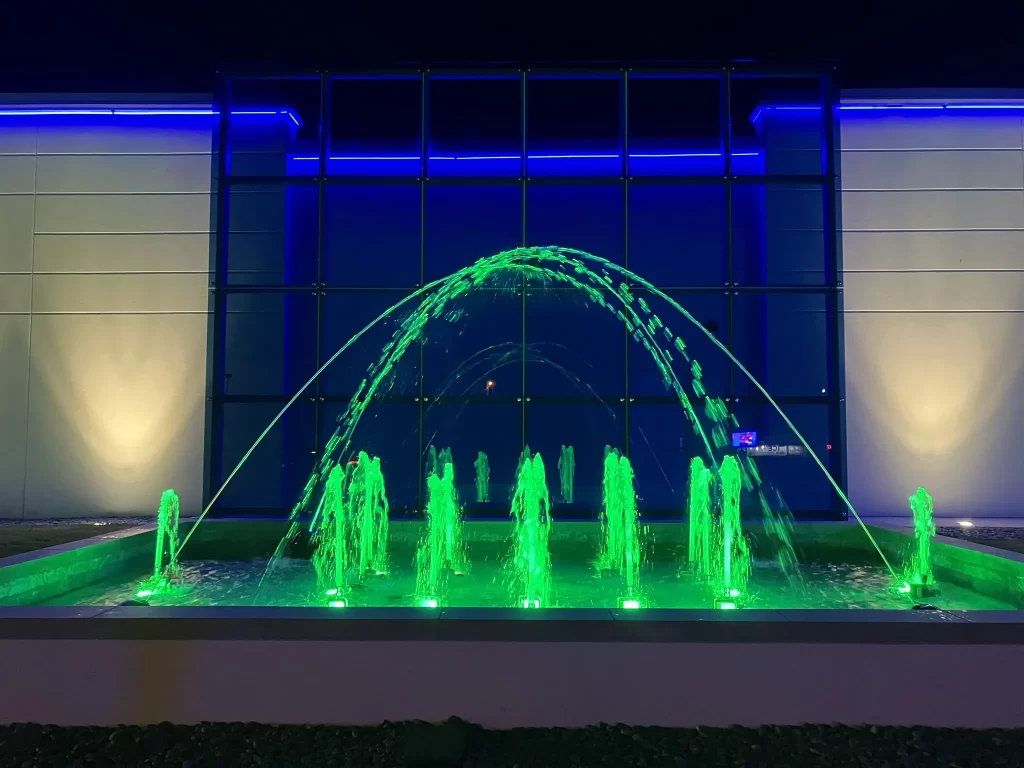A Breakthrough in Fountain Flow Control?


With the introduction of its SplashValve, manufacturer SplashBotix believes the device has the potential to revolutionize the way show fountains and interactive water features are designed. In this Q&A discussion, Ronn Garland, the company’s program director and the valve’s creator, explains how it works.
By Eric Herman
From the fountains at Versailles in Paris to the Bellagio in Las Vegas, throughout history, fountain technology has often represented some of the most advanced forms of hydraulic engineering. To this day, the ability to precisely control water’s flow, shape, direction, sequence and even texture, is ever-expanding with each new generation of fountain-control technology.
Having covered fountain design in these pages for nearly 25 years, I was intrigued when the folks at SplashBotix reached out to WaterShapes this past summer in an effort to promote their new SplashValve, a device they represent as a game-changing advancement in fountain design and control.
I was curious to learn more about it in greater detail, and thusly responded with a list of questions aimed at understanding the product’s development process and how it works. The company answered with responses from Ronn Garland, who originally envisioned and developed the concept.
WS: What is a SplashValve?
RG: The SplashValve (SV) is a new kind of fast-acting water switch that enables nozzle-level proportional flow control in fountains and water features rather than simply on/off flow control. Unlike conventional water switches, the SV does not use often- temperamental and high-maintenance pneumatic valves to divert flow. Instead, the SV uses a DMX-controlled, servo-electric actuator and proprietary zero-loss diverter valve to enable variable height control with both high reliability and performance.
When was it developed?
The need for a solution like the SV had been knocking around in my head for some time prior to the first conceptual designs and experiments here at ARM. The team here saw a lot of value in a product that could reduce fountain designers’ dependence on pneumatic water switches, on/off solenoid valves and/or large arrays of distributed effect pumps for dynamic fountains, water features and splash pads. In collaboration with ARM’s deep bench of highly-experienced engineering talent, we built and tested the first-generation product in 2019.
Did it go through different design iterations in the development process?
The SV has gone through multiple design iterations since the first-generation prototype. Now in its third-generation design, the SV has undergone iterative improvements in speed, serviceability and reliability.
What are the drawbacks of a solenoid valve?
Solenoid valves are only capable of opening and closing, and don’t allow for proportional flow control. They also create a violent and sometimes damaging “water hammer” effect as the valves open and close. These spikes in pressure adversely impact fountain or splash pad water effects and can damage other components in the system.
While there are other proportional valving solutions capable of gradually opening or closing, such as servo valves, these solutions do not allow for constant back pressure. That means that designers cannot manipulate individual nozzle flow heights without impacting manifold pressure and affecting the behavior of all the other nozzles operating on the same manifold.
In contrast, the SV enables proportional flow control not by stopping or obstructing the flow of water, but by leveraging its uniquely shaped diverter valve to change the direction the water is flowing. This enables the water supply to flow continuously and ensures that the pressure in the manifold remains undisturbed even as SVs operating on the same manifold independently switch between flow positions.
Does it simplify hydraulic design and calculations because the flow stays the same?
In comparison to systems that use other proportional valving technologies, or binary on/off valving technologies, it is generally easier to design and calculate the flow of systems that use SVs. Compared to valving technologies that stop the flow of water, the SV is much easier to use because it maintains constant manifold back pressure without the use of additional pressure-mitigating technologies such as pressure-relief valves.
Compared with other near-constant back pressure devices like water switches, calculating flow with SVs is easier because they are more efficient and perform more consistently over a greater range of conditions. By using a robotic actuator rather than complex pneumatics to divert water, SVs place only minimal resistance on supply systems, allowing pumps to operate much more efficiently and at lower speeds.
Furthermore, the SV’s switching performance is consistent irrespective of pump speed, while water switches tend to perform worse at higher pump speeds. From a hydraulic design perspective, therefore, there are more constraints that need to be considered when working with water switches versus SVs.

Does it make it easier and more affordable to create fountain effects?
The SV makes it much easier and more affordable to design, build and create show- fountain-quality water features compared with distributed pump fountains and fountains featuring solenoids or pneumatic water switches.
Does it require less maintenance?
As a manifold-mounted proportional flow control device, the SV facilitates a simpler, more robust and reliable show or dancing fountain infrastructure compared with distributed pumps. Using multiple high-voltage effect pumps on dancing fountains generally requires the use of additional electrical infrastructure to protect the installation and the public from potentially dangerous leakage current.
The SV, by contrast, is a much lower voltage (20W 12VAC/24VDC) technology. The additional infrastructure required among distributed effect pump fountains, therefore, isn’t needed on installations that use SV. Compared with water switches, SVs make the installation process much simpler.
Among conventional single manifold fountains employing water switches, mechanical “balancing” valves installed beneath each nozzle typically need to be physically calibrated to ensure flow rates are consistent and can facilitate designers’ desired fountain effects.
Given the SV’s high-resolution proportional-flow control capabilities, however, fountains using SVs can be adjusted remotely using RDM (remote device management). This feature spares installers from having to make manual adjustments in the field, which can be difficult, physically demanding and typically involves getting wet.
From a cost perspective, operators of SV-enabled fountains can realize tremendous savings in the maintenance and longevity of their system compared with distributed pump- and water switch-enabled systems. Given its rugged construction, the SV requires far less maintenance and lasts much longer than fountain effect pumps and conventional water switches.
Conventional water switches use complex pneumatic valves that require a snorkel to switch water between effect and bypass. The pilot valves in these snorkels frequently get clogged with debris and atmospheric dust, requiring some level of maintenance once every few weeks.
Fountain-effect pumps, meanwhile, use fine mesh filters, which also require frequent cleaning, particularly when used in heavily polluted environments. They also use dynamic seals and rely on a large number of moving parts, presenting more modes of potential failure. The SV’s internal diverter mechanism is magnetically coupled to the motor, which is literally encased in 316 stainless steel, making it next to impossible for the SV’s electronics to become exposed to water.
Who is the target market?
The SV’s target markets include fountain, splash pad, water park and special effects designers, engineers, installers and contractors. The value proposition for these markets is that the SV, when compared with alternative solutions, presents a simpler and more robust means of developing high-quality fountains, splash pads and water features, while empowering show programmers and designers with greater creative flexibility. Particularly among fountain rehab contractors, the SV also presents a valuable retrofit solution capable of transforming simple, non-articulating fountains into dynamic, show fountain-quality installations.
As previously discussed, another major selling point, particularly salient for installers, is the fact that SVs allow for a greater share of the fountain startup process to be done remotely. Due to the SVs high-resolution, proportional-flow capabilities, installers no longer need to get into the fountain or wet environment in order to balance a fountain. Fountain balancing can be done entirely by manipulating each SV’s RDM setting.
Finally, the amount of maintenance SVs require is minimal compared to effect pumps, solenoid valves and pneumatic water switches. Its rugged 316 stainless steel construction and lack of dynamic seals also makes the SV the longest-lasting option, with far fewer modes of potential failure.
What type of testing has the product gone through?
For more than two years, our test pool has been running the same five SVs, which have now recorded nearly 20 million diverter cycles without failure. These SVs run outdoors under the hot Texas sun in water our team frequently fills with abrasive media to try to push the SV’s wear-resistant construction to its limits.
The device has also been operated in temperatures ranging from 32F to 100F as a means of testing its thermal resilience. The units have been cleaned three times, including once at 5 million cycles, once at 10 million cycles and once at 19 million cycles. Wear measurements taken after each device cleaning showed virtually no device wear.
We will continue to monitor these SVs as they surpass 20 million cycles and have no plans currently to cease lifecycle testing. Each production SV goes through extensive and rigorous testing before being shipped to customers or being installed in the field. These tests ensure that each SV is appropriately vacuum sealed, capable of operating seamlessly at a wide range of temperatures, and that it responds properly to DMX (popular show programming language) and RDM commands.
Are there different sizes?
We were very intentional about designing the SV such that it could be easily used on installations, and paired with nozzles, of any size. The SV’s inlet, bypass and effect ports are all threaded 1-inch NPT, and its length from inlet port to effect port is 4 inches. Using a simple one-inch nozzle adapter, the SV can host any size nozzle the customer wants and across these nozzles, performance is consistent.
How is it controlled?
The SV is controlled using DMX and is an 8-bit single-channel DMX device. 8-bit means that, in DMX, the SV’s diverter mechanism can respond to 255 unique commands. In the context of a fountain show, 255 corresponds to the granularity or resolution with which nozzle heights can be manipulated using the SV. Essentially, there are 253 unique flow heights the SV can be set to between full effect and full bypass.
The SV’s internal software also includes an RDM feature. RDM enables show designers to set each SV’s DMX address and configure various parameters that affect how the SVs perform in relation to the DMX commands they receive.
What are the functional limits of the SV?
The SV is designed to operate in environments and at internal temperatures ranging between 10°C and 40°C. It can operate at pressures of up to 50 PSI and can be continuously submerged up to 3 meters or 10 feet. The device’s internal diverter mechanism can switch from full bypass to full effect in roughly .11 seconds, and from bypass to effect and back to bypass in less than .23 seconds. This fast-switching speed allows the SV to achieve a unique “water marbling” effect.
Fountain photo courtesy of Roman Fountains.










